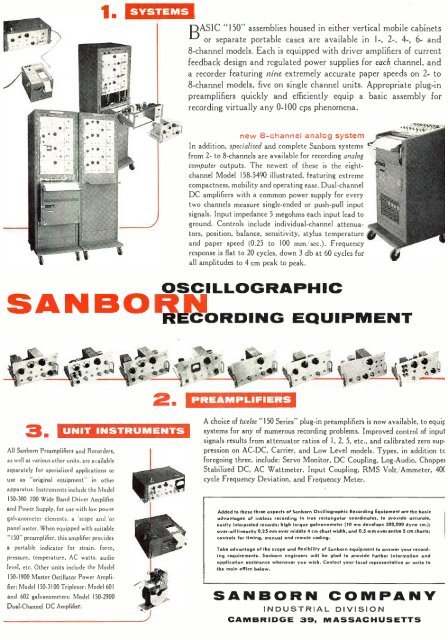TELE-TECH & - AmericanRadioHistory.Com
TELE-TECH & - AmericanRadioHistory.Com
TELE-TECH & - AmericanRadioHistory.Com
Create successful ePaper yourself
Turn your PDF publications into a flip-book with our unique Google optimized e-Paper software.
SYSTEMS<br />
BASIC "150" assemblies housed in either vertical mobile cabinets<br />
or separate portable cases are available in 1 -, 2 -, 4 -, 6- and<br />
8- channel models. Each is equipped with driver amplifiers of current<br />
feedback design and regulated power supplies for each channel, and<br />
a recorder featuring nine extremely accurate paper speeds on 2- to<br />
8- channel models, five on single channel units. Appropriate plug -in<br />
preamplifiers quickly and efficiently equip a basic assembly for<br />
recording virtually any 0 -100 cps phenomena.<br />
new 8- channel analog system<br />
In addition, specialized and complete Sanborn systems<br />
from 2- to 8- channels are available for recording analog<br />
computer outputs. The newest of these is the eight -<br />
channel Model 158 -5490 illustrated, featuring extreme<br />
compactness, mobility and operating ease. Dual- channel<br />
DC amplifiers with a common power supply for every<br />
two channels measure single -ended or push -pull input<br />
signals. Input impedance 5 megohms each input lead to<br />
ground. Controls include individual -channel attenuators,<br />
position, balance, sensitivity, stylus temperature<br />
and paper speed (0.25 to 100 mm /sec.). Frequency<br />
response is flat to 20 cycles, down 3 db at 60 cycles for<br />
all amplitudes to 4 cm peak to peak.<br />
OSCILLOGRAPHIC<br />
SANBORN<br />
RECORDING EQUIPMENT<br />
2. PREAMPLIFIERS<br />
3.<br />
All Sanborn Preamplifiers and Recorders.<br />
as well as various other units, are available<br />
separately for specialized applications or<br />
use as "original equipment' in other<br />
apparatus. Instruments include the Model<br />
150 -300, 700 Wide Band Driver Amplifier<br />
and Power Supply, for use with low power<br />
galvanometer elements, a 'scope and,'or<br />
panel meter. When equipped with suitable<br />
"150" preamplifier, this amplifier provides<br />
a portable indicator for strain, force.<br />
pressure, temperature, AC watts, audio<br />
level, etc, Other units include the Model<br />
150.1900 Master Oscillator Power Ampli.<br />
fier: Model 150 -3100 Triplexer; Model 601<br />
and 602 galvanometers; Model 150-2900<br />
Dual -Channel DC Amplifier.<br />
UNIT INSTRUMENTS<br />
A choke of twelve "150 Series" plug -in preamplifiers is now available, to equis<br />
systems for any of numerous recording problems. Improved control of input<br />
signals results from attenuator ratios of 1, 2, 5, etc., and calibrated zero suppression<br />
on AC -DC, Carrier, and Low Level models. Types, in addition tc<br />
foregoing three, include: Servo Monitor, DC Coupling, Log- Audio, Chopper<br />
Stabilized DC, AC Wattmeter, Input Coupling, RMS Volt /Ammeter, 40(<br />
cycle Frequency Deviation, and Frequency Meter.<br />
Added to these three aspects of Sanborn Oscillographic Recording Equipment are the basic<br />
advantages of inkless recording in true rectangular coordinates, to provide accurate,<br />
easily interpreted records; high torque galvanometer (10 ma develops 200,000 dyne cm.);<br />
over -all linearity 0.25 mm over middle 4 cm chart width, and 0.5 mm over entire 5 cm charts;<br />
controls for timing, manual and remote coding.<br />
Take advantage of the scope and flexibility of Sanborn equipment to answer your recording<br />
requirements. Sanborn engineers will be glad to provide further information and<br />
application assistance whenever you wish. Contact your local representative or write to<br />
the main office below.<br />
SANBORN COMPANY<br />
INDUSTRIAL DIVISION<br />
CAMBRIDGE 39, MASSACHUSETTS
















